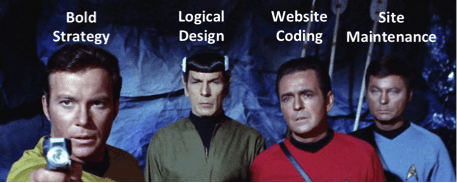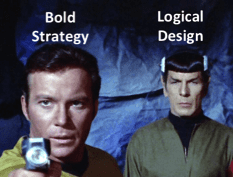There are four critical steps to overhauling your website:
- Strategy and messaging
- Design
- Coding
- Maintenance
That is, first conceive the brand message. That’s the winning strategy, the competitive advantage that can lead to increased revenue and profitability. That’s what turns a new website into a weapon, rather than an online brochure.
Then turn that message and the supporting visuals into an attractive, user-friendly design. Then code the site using the latest features, and then ensure that it stays secure and up to date. A simple, step-by-step process.
In website-overhaul RFPs, we typically compete against any number of “the usual suspects,” i.e. well-known companies that create attractive, nicely functioning sites. We’re in a website competition now for a law firm that claims to want to “demonstrate leadership” and “enhance [their] image and visibility.”

At Fishman Marketing, we often struggle to explain the difference between Strategy and Design, i.e. between “effective” and “attractive.” Few lawyers have the high-level marketing education to know the difference between (1) a strategic website supporting a specific plan designed to increase revenue, and (2) attractive pictures with a pleasing layout.
Here’s what we’ve seen: 90% of website companies offer “attractive,” not “strategic.”
Why? Because most website companies are run by technical experts, not marketers. They have B.S. degrees. They’re fundamentally math / science people, like accountants. They’re important, but “strategy” isn’t their primary skillset.
To use an old TV analogy, in Star Trek it was Captain Kirk’s job to “boldly go where no one has gone before.” He knew the goals and mission for the Enterprise. He was responsible to see the big picture and set the course for the future. Once he’d determined the destination, then he turned over responsibility to Mr. Spock to handle the minutiae and help get there.
Then Scotty, the engineer, ensured that the technical equipment was up to the task. Then Dr. “Bones” McCoy kept everyone in the system healthy. That’s a useful metaphor for a basic website overhaul. That is:
- Kirk is the brand strategist. He identifies the vision and sets the direction.
- Spock is the web designer. He creates an effective layout.
- Scotty codes the site. He executes Spock’s direction.
- Bones handles site maintenance. He keeps it updated and secure.
That’s an efficient process where each person had a specific role that leveraged their education and skills and played an important part in the successful accomplishment of the mission. But the personnel are not interchangeable.
If you took Kirk out of the process, you get a website designed by a scientist. That is, a logical, technically efficient site, but one that could be interchanged with any of your close competitors.
The problem is, there’s no story. It’s benign and innocuous. You don’t stand out.
Why? Because there’s no Capt. Kirk — no one to ensure you “boldly go” anywhere.
There’s nothing that shows how you’re leaders, or a better option than the numerous look-alike players in your market.
If your 5-year mission is “Stay right where we are now,” then save your money.
If you want to tread water, hire an inexpensive website company and buy a nice-looking template — if your expectations are low enough, anyone can achieve them. If your goal is to “make your old website less embarrassing” then any Spock can accomplish that goal — and the industry is full of smart, skilled Spocks.
If you want to “take your firm to the next level,” if you want to leap-frog your competitors, then you need a Kirk.
There aren’t many Kirks in the website industry, which makes them easy to spot. If it’s not obvious who the Kirk is on your website-overhaul team, then you ain’t got one. Nine out of ten times, you won’t.
A website overhaul is one of a firm’s rare opportunities to “go boldly.”
Do you want to make more money next year?
Do you want to become leaders in your market?
Think Trek. Not tech.
——————————–
Need an effective new website or brand for 2017?
Or perhaps marketing training or Ethics CLE?
Contact Ross at 1.847.921.7677 or ross@fishmanmarketing.com.



